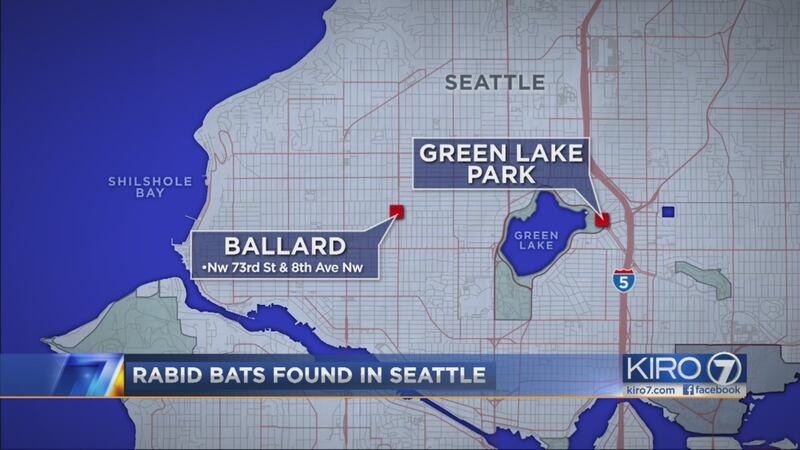SEATTLE — As summer comes to a close, the reports of rabid bats found in residential Puget Sound communities seem to be on the uptick.
The primary reservoir of rabies in the Northwest is bats according to Washington State Department of Health.
Twenty rabid bats were identified last year, with only one located in western Washington County.
So far this year, 21 bats have been found across the state; most recently they've been discovered in Green Lake, Ballard, and SeaTac.
They have all been captured and euthanized, but anyone who touched the bat may be at the risk of rabies, which is almost always fatal once symptoms begin.
Look at the map below and see where some of rabid bats have been found, and click an icon for details on the location. You can also scroll down to read about exposure and what to do if you find a bat.
If you’re concerned about exposure, call King County Public Health immediately at 206-296-4774 to get information about preventative treatment. This includes touching a bat, being bitten, scratched, or any other bare skin contact with a bat or its saliva.
More than 15 species of bats live in Washington, and the most common seen in human habitat include the little brown bat, Yuma myotis, big brown bat, pallid bat, and California myotis.
King County Public Health is working to learn why more bats are showing up this year, but they partially attribute it to people being more observant and actually reporting the bats.
Scroll down to keep reading.
TRENDING NOW:
- Father killed on I-5 after daughter runs out of gas
- Seattle bikes left in bizarre places; share program sends message to 'bad players'
- Georgia cop during traffic stop: 'Remember, we only kill black people'
- SPD officer fired by department to get back pay and termination reversed
- 3 Seattle brothers in child porn probe expected to appear in court
More about bats
Bats flying overhead, and bats that have not had direct contact with humans or animals, do not pose a risk for transmitting rabies. Healthy bats will avoid people, so be suspicious of a bat you find inside your home or on the ground.
If you find a bat:
- If you find a bat inside your house, call Public Health at 206-296-4774 to discuss the situation and to determine whether the bat needs to be tested for rabies. Public Health tests bats for rabies free of charge under certain circumstances.
- If the bat is alive, do not let it go! Knock it to the floor with a broom or other object, and cover it with a wastebasket or other container. Scoop it into a box or plastic storage container with a secure lid without touching it or wear heavy leather gloves to pick it up and put it in the box.
- Use a shovel or gloves to put a dead bat in a box for testing. Do not throw it away!
More about rabies
Rabies is dangerous, but treatable if caught early:
- If someone has had contact with the bat, treatment can prevent infection. This treatment should be given as soon as possible.
- Once symptoms develop, rabies cannot be treated and leads to death in virtually all cases.
Rabies is a viral disease of the central nervous system that is almost always fatal once symptoms begin. The virus is found in the saliva of an animal with rabies and is usually transmitted by a bite or scratch. In Washington State, between 3-10% of bats tested for rabies are positive, though the bats that are tested are usually sick or injured; less than 1% of healthy bats are infected with rabies
Because rabies is a life threatening disease, medical advice must be sought promptly if a bat comes into contact with humans or animals.
Rabies and pets
Pets might have been exposed as well. If your pet might have been exposed, contact your veterinarian immediately. Dogs, cats and ferrets should be current on their rabies vaccine but will need to be revaccinated if they had contact with a bat.
For more information about bats and rabies, and how to safely avoid bats, click here.
Cox Media Group








